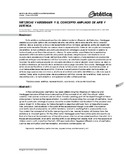Nietzsche y Heidegger y el concepto ampliado de arte y estética
Fecha
2009-07-21Autor
Palabras Clave
Estética, Representación, Apariencia, Arte contemporáneoAesthetics, Performance, Appearance, Contemporary art
Metadatos
Mostrar el registro completo del ítemResumen
En la estética contemporánea ha sido determinante la influencia de Nietzsche y Heidegger debido a su amplia óptica del
concepto de arte, del artista, de la obra de arte, de la creación artística, de sus espacios e incluso del espectador-crítico. En líneas generales, parte del objeto del pensamiento de estos filósofos se vuelca sobre la representación. Además de ampliar el concepto de estética, le han conferido una particular dimensión ontológica, pues la
tradición moderna la había situado en el Gran Arte universal y clásico. En este sentido, para Nietzsche la realidad se representa artísticamente a partir de una pulsión apolínea, del principium individuationis en el mundo de la apariencia a través del hombre-artista. Toda ciencia y toda realidad son producidas poiéticamente por una tendencia artística humana y es arte todo aquello que sea producido por el hombre. De este modo se amplía el concepto de arte a la vida al devenir, al ser mismo, es decir a la óptica dionisiaca en función de la existencia como juego inocente. Por su lado, Heidegger atisba estos alcances filosóficos al afirmar que el arte es la forma más clara de la voluntad de poder, el cual debe entenderse desde el artista. El arte es la eventualidad fundamental de todo ente y el ente es algo que se crea a sí mismo, el arte es el
contramovimiento del nihilismo y vale más que la verdad. Todas estas implicaciones desencadenaron distintas visiones de la
estética, tales como la deconstrucción y la hermenéutica, e impulsaron el arte contemporáneo.
Colecciones
Información Adicional
| Correo Electrónico | naviamau@ula.ve |
| ISSN | Revs-0002 |
| Resumen en otro Idioma | In the contemporary aesthetics has been determining the influence of Nietzsche and Heidegger because of their broad perspective of the concept of art, artist, the artwork, artistic creation, their spaces and even viewer-critical. Broadly speaking, part of the object thought of these philosophers is turned on the representation. In addition to expanding the concept of aesthetics, have given it a particular ontological space, since the modern tradition had located it in the universal and classic Great Art. In this sense, for Nietzsche reality is depicted artistically from an beautiful impulse, from principium individuationis in the world of the appearance through man-artist. Any science and reality are all produced by an artístic tendency and art is anything that is produced by man. Thus widens the concept of art to life, becoming and to be, namely to optics of Dionisos from the existence as innocent game. On the other hand, Heidegger warns these philosophical scope to say that art is the most transparent way of the will to power, which must be understood from the artist. Art is the essential eventuality of all entity and the entity is something that creates itself, art is the opposite of nihilism and is worth more than the truth. All these implications triggered different visions of aesthetics, such as deconstruction and hermeneutics, and drove contemporary art. |
| Colación | 99-108 |
| Periodicidad | semestral |
| Publicación Electrónica | Revista Estética |






